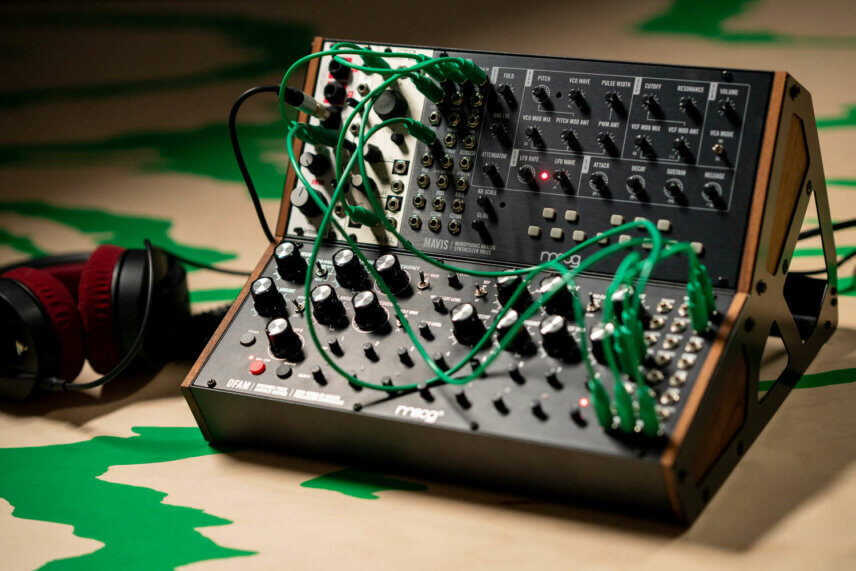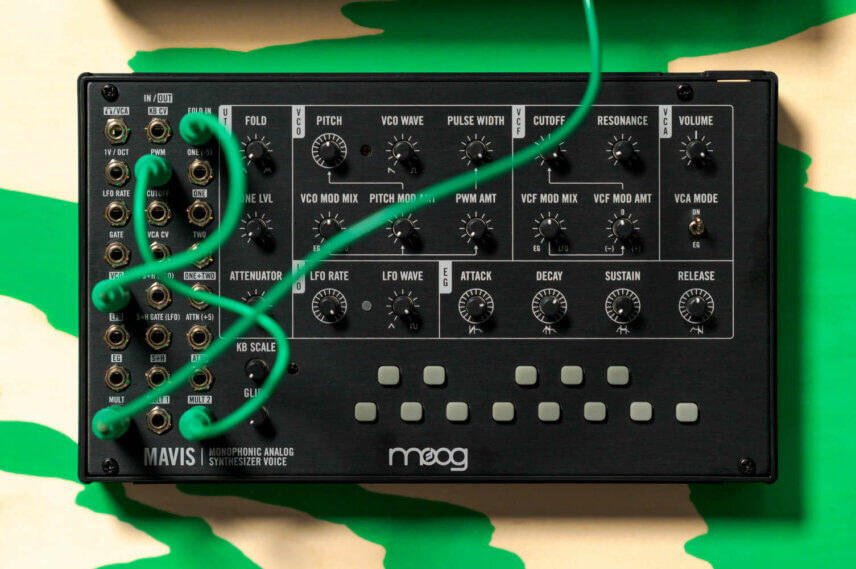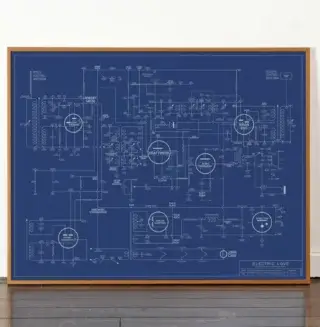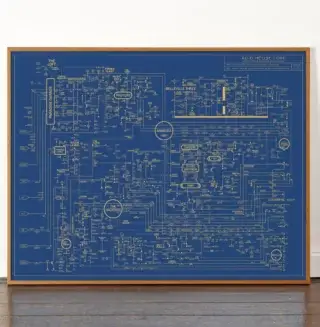Folllowing on from the proposition Minimoog is more influential than Les Paul, Darren Selement uses the Moog Mavis to highlight why semi-modular synths matter.
The third electronic instrument I bought, after a Casio Pt-1 and a Jupiter 6 purchased secondhand, was a sampler. It was 12-bit grit. I wanted to invent sounds that ached with the echo of an empty townhouse garage. Einstürzende Neubauten via suburbia.
It was a small fortune for a kid out of school and bookstore work doesn’t pay but I bought it. That machine turned me into a sonic revolutionary desperately trying to capture lightning strike sounds in the bottle of a sample.
If only I knew what a compressor was or, for that matter, a good microphone. If only there were internet tutorials. If only didn’t matter. I learned to take chances, risk destruction, and how to sample through headphones, and hope… Then it came time to loop. Some of us have been there. Some of us have been tempted to launch a machine across the room when the crossfade clicks, the loop sticks, the CPU crashes, but the sound on the editing table was a simple noise loop, not the fade out of a cello.
I still own that machine and those sounds.
Certain that my knowledge of programming hardwired synthesizers and my experience of diving into sampling would clear me from hitting the bottom, I leapt into modular synthesis. I came up short in the deep end.
I’ve written about it before: How the DFAM Changed My Modular Life.
The life raft gift of a Moog DFAM helped me surface but at the end of most of my modular sessions, I still found myself lurking in the murky waters of 1octave to 1volt behemoths and attenuated-attenuverted leviathans. All breakneck impact and drowning with monsters in the water metaphors aside, there are concepts to address when it comes to checking the depth before taking the dive.
Part One – The Oscillator is Always On™
(CV Gurus, Shamans of Triggers, and Sages of Signals are welcome to skip the following section and head straight to the part titled: History. Democracy. Anarchy.)
Modular synthesis is backwards. Technically, it isn’t but it can seem that way. When the classic order of operations is to press a key on a keyboard that triggers a preset/saved synthesized sound, modular synthesis can feel like, well, diving deep into the wrong end. That is the last diving metaphor, I hope.
Power up the machine, the modular boat, the large-paper-weight-destined-for-defenestration, call the synth what you want, the oscillator is on. Plug headphones into the Saw or Sine wave out and the oscillator hums in an unwavering drone or existential scream, oscillating at the chosen pitch. Tweak the tuning at will but wherever the knob stops the oscillator remains in a sustained state of rumble or shrieking or pleasant hum. It’s exciting for a few seconds or even minutes. The oscillator requires some guidance. The rest of the patch does too.
Plug headphones into a patchless VCA, voltage-controlled-amplifier, and it makes silence. Why? Because not only does the VCA need a sound source, see oscillator, it doesn’t exactly amplify sound. Closer to the truth, the VCA reduces volume.
The concept is completely contrary to plug an electric guitar into an amplifier, turn it up, and out comes noise. It is the opposite of plug a hardwired synth into an amp choose a preset and voila out comes thunder.
Confused? It’s time to talk politics.
Part Two: History. Anarchy. Democracy
Electronic music has been celebrated for changing culture through music and style and equally vilified for taking orchestra pit and studio musician jobs. Somewhere in between that apex of sound and theft is the truth. Somewhere in between exists culture.
The 808. The 303. MASSIVE.
All three machines all genre defining synthesizers. Either initially disregarded as inferior and found in secondhand shops or the beneficiary of Moore’s Law, the metronomic theory that every two years the number of transistors on microchips double and CPUs get exponentially faster, those three machines had two things in common. They were pawn store affordable and Hardware or soft, each of them would go on to brand cities with an iconic sound: Detroit. South Central. London. Tokyo. New York. Berlin. Etc.
Appropriate. Break. Initiate.
Approximately 10 years after The 808 and 10 plus years before MASSIVE, Dieter Doepfer twisted the classic tradition of finding instruments in secondhand stores. He dumpster dove to find manuals. He sent letters to meet with inventors and engineers to hunt for specs in cobwebbed file cabinets. He got his hands dirty. He had no choice. At the time, the perfect circuit solution of knowledge and information dubbed the internet had barely taken its first breath. Dr. Frankenstein or not, in the shadows of presets, Dieter Doepfer reinvented a machine without limitations. He resuscitated a monster: The Modular Synthesizer.

It wasn’t the size of the machine that made the change massive.
The Oscillator Never Stops.
Modular synthesis is, by intention, limitless. It is also elitist. Elite in cost. Elite in knowledge. There is nothing democratic in the process. That sort of freedom, the ability to choose every detail comes at a cost. Curating a modular machine is personal. This isn’t picking which sort of cereal in a grocery aisle sounds good this afternoon. Equally inspired by the module designers as it is by the individual who configures the monster, the machine will be a beautiful piece of form and function, not a formulated RnD taste sensation.
The 808 and The 303 were hardware easy in their own way. MASSIVE, by way of ready to abuse presets was, too. Modular synthesis doesn’t frequent that sort of democracy. The cost of patching a sound, not even a great one, requires more than a turn on, press preset, and get a kick drum thump or screaming lead sound. The limitless variables pure modular synthesis offers are thrilling. They’re daunting. Complete freedom, Anarchy, is elite, expensive, forces diligence, careful choices, and knowledge. It also requires a bit of luck and random chance patches. To paraphrase Richard Devine; Sometimes you go to your studio planning on one thing and end up with something completely unexpected and exciting.
Part Three: Enter Moog MAVIS
MAVIS, the name, means songbird in French. It alludes to the beautiful singing voice of the thrush bird. MAVIS, the semi-modular synthesizer from Moog, is capable of singing. It can also gut perfect tones with acrid and acidic timbres. Half hard-wired and affordable, Moog MAVIS is a semi-modular synth that offers democracy in the world of elitism.
Monophonic at heart, patched correctly, the LFO on the Moog MAVIS becomes a second oscillator. Suddenly Duo-phonic synthesis, all cacophony or subtle variations included, comes flowing out. Patch and twist at will and the machine spits out punchy leads, bass thump, and can casually return to classic modular plinks, plucks, and broken S&H loops.
At first, I chose to avoid using my 7U Eurorack rig and focus on MAVIS within its own parameters. Ultimately, the inevitable won and I pushed the machine. I patched the CV Pitch, Gate, Attenuator, and Fold-In using the midi to CV convertor on my Eurorack along with Ableton. The sounds I created floated from ethereal modulating drones to cranky fragmented industrial tones. I found some classic solid bass thumps, too.

My favorite sound source included patching the LFO Rate out to the CV in on the MAVIS patch bay with a stackable cable patched to my Keystep Pro CV. I twisted the KB Scale to change the intervals on the MAVIS keyboard and played the tiny MAVIS keyboard by hand while a sequence from the Keystep Pro hit at the same time. Despite its small size (mountable in Eurorack format), the angular riffs and controllable tones that came out of the machine were heavy. Do not expect a Model D or a Model 10 or any of the iconic machines listed above but MAVIS rattled speakers and growls in similar ways to its ancestors.
Somewhere between the thick oscillator and that classic ladder filter, Moog finally introduced a sonic spectrum long missing from their synthesizers. MAVIS has the first ever wavefolder on a Moog. That patch bay plug and knob makes MAVIS special. It is a gamechanger for Moog. Every subsequent Moog, especially a revived Voyager (hint), should have a wavefolder.
Like every semi-modular synth there are issues with MAVIS. The crowded patch bay makes random live patching somewhat impossible. It does not accept midi and does not have an arpeggiator. The tiny knobs, especially in live recording moments, are difficult to nuance. (Note: One day after I submitted this article Moog released a new set of knobs for the MAVIS, DFAM, and SubHarmonicon. I haven’t used the knobs but it appears they might help the issue.) MAVIS isn’t perfect. MAVIS has limitations. Limitations don’t invite chance and change, they force them.
The first time I learned to understand an instrument so completely was with my 12-Bit sampler. That machine continues to inspire my choices in sound. MAVIS teaches the same lesson: It is better to learn more with less than to have it all. In a digitally synthetic world where everything is sonically available, and modulatable, and quasi-relatable, limitations are benefits. Like pawnshop finds, limitations matter.
Limitations inspire art.
Final Thoughts On The Moog Mavis
In 10 years will electronic musicians hunt in secondhand stores trying to find the ancient white whale computer to wild-sync Version One of MASSIVE to the latest DAW because those machines had a perfect circuit flaw?
Like every semi-modular synth, MAVIS offers a well-guided pathway to the anarchy of sound called modular synthesis. It is equally special because it updates the Moog sound with a wavefolder, a huge step forward.
Buy Moog Mavis on Thomann.
*Attack Magazine is supported by its audience. When you purchase through links on our site, we may earn an affiliate commission. Learn more.
Darren Selement lives in western North Carolina, a short walk from Make Noise and a short drive to Moog. Divided but certain that if he threw a stone he’d hit a synthesist with an opinion on which approach was better, he is sure that from samplers to drum machines every choice is personal, and none are wrong.







